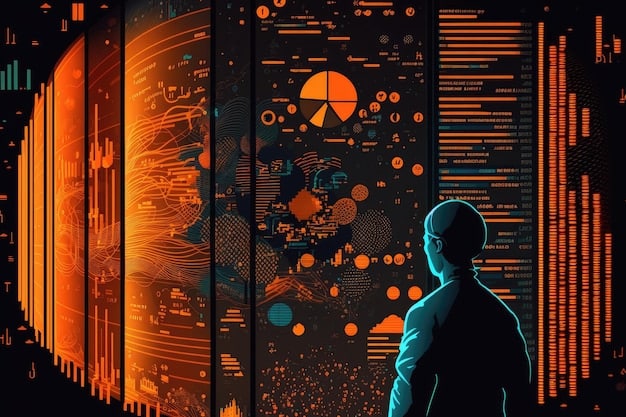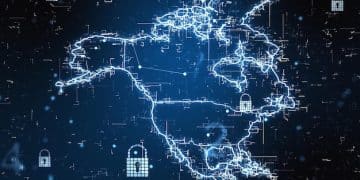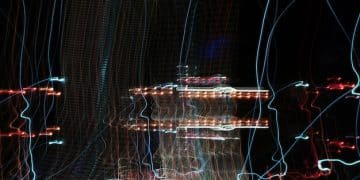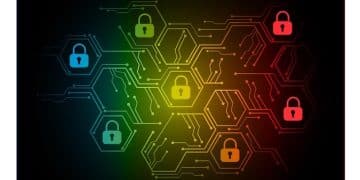Quantum Computing & US Data Security: 2025 Outlook

The rapid advancements in quantum computing present a dual-edged sword for US data security in 2025, offering both unprecedented cryptographic vulnerabilities and the potential for intrinsically secure communication protocols, necessitating immediate strategic adaptations by government and industry.
As we approach 2025, the landscape of cybersecurity is poised for a transformative shift, driven significantly by the burgeoning field of quantum computing. Understanding what new quantum computing developments mean for US data security in 2025 is not merely an academic exercise; it’s a critical imperative for safeguarding national interests, economic stability, and individual privacy. We’re beyond the realm of theoretical physics, entering a phase where the practical implications of quantum technology become increasingly tangible, presenting both profound challenges and unparalleled opportunities for the United States’ digital defenses.
Understanding the Quantum Leap in Computing
Quantum computing represents a paradigm shift from classical computing, leveraging the principles of quantum mechanics—superposition, entanglement, and interference—to process information in fundamentally new ways. While classical bits operate in binary states (0 or 1), quantum bits, or qubits, can exist in multiple states simultaneously, exponentially increasing processing power. This inherent difference is why quantum computers hold the potential to solve problems intractable for even the most powerful supercomputers today, problems critical to cryptographic security.
The journey from theoretical concept to practical application has been rapid. Initially confined to highly specialized labs, quantum computers are now becoming more accessible, albeit still in nascent stages. Companies and research institutions are pushing the boundaries of qubit stability, coherence times, and error correction, leading to systems with increasing numbers of usable qubits. These developments, though incremental, signal a accelerating trajectory towards practical quantum advantage.
Foundational Quantum Principles
To grasp the security implications, it’s essential to briefly touch upon the core ideas:
- Superposition: Unlike classical bits, a qubit can be 0, 1, or both simultaneously, allowing for parallel computations that far exceed sequential processing.
- Entanglement: Two or more qubits can become linked in such a way that the state of one instantaneously influences the state of the other, regardless of distance. This is crucial for certain quantum algorithms.
- Quantum Tunneling: While not directly a principle of quantum computation, the ability of quantum particles to pass through energy barriers contributes to the unique behaviors exploited in quantum systems.
These principles enable quantum algorithms that could revolutionize fields from medicine and materials science to financial modeling and, most crucially for this discussion, cryptography. The progress in perfecting these quantum behaviors in real-world hardware is defining the pace of quantum development globally.
In the context of data security, the ability of quantum computers to perform these complex calculations simultaneously and efficiently is what makes them both a formidable threat and a powerful tool. The current state of quantum hardware suggests that while general-purpose, fault-tolerant quantum computers are still some years away, specialized quantum systems operating in a noisy intermediate-scale quantum (NISQ) era are already showing capabilities that could impact specific cryptographic protocols by 2025, prompting urgent defensive strategies.
The Double-Edged Sword: Quantum Threats to Current Cryptography
The most immediate and talked-about implication of quantum computing for data security is its potential to break current cryptographic standards. Much of the world’s digital security infrastructure relies on public-key cryptography, specifically algorithms like RSA and Elliptic Curve Cryptography (ECC), which derive their strength from the computational difficulty of factoring large numbers or solving discrete logarithm problems. These problems are practically intractable for classical computers, but not for quantum ones.
Shor’s algorithm, discovered by Peter Shor in 1994, is a quantum algorithm capable of efficiently factoring large numbers and solving discrete logarithms. While current quantum computers lack the coherence and number of qubits to execute Shor’s algorithm on cryptographically relevant key sizes, the continued exponential growth in quantum computing power suggests this capability is not a distant fantasy but a future inevitability. Estimates vary, but many experts believe that within the next decade, and potentially as early as 2025 for specific, less-resilient implementations, the threat will become very real.
Specific Cryptographic Vulnerabilities
- RSA and ECC: These widely used algorithms, fundamental to secure web browsing (HTTPS), digital signatures, and secure communication, are directly vulnerable to Shor’s algorithm. Their reliance on factoring large prime numbers and discrete logarithms is their Achilles’ heel in a quantum world.
- Symmetric Key Cryptography (e.g., AES-256): While less vulnerable than public-key systems, quantum computers running Grover’s algorithm could theoretically halve the effective key length, meaning a 256-bit key would have the security equivalent of a 128-bit key against a quantum attack. While concerning, it’s generally considered that doubling the key size can mitigate this particular threat for symmetric systems.
- Hash Functions (e.g., SHA-256): Hash functions are also susceptible to Grover’s algorithm, potentially reducing their collision resistance. However, the impact is less severe than on public-key cryptosystems.
The “harvest now, decrypt later” problem is a significant concern. Malicious actors, including state-sponsored entities, could be collecting encrypted data today with the expectation of decrypting it once sufficiently powerful quantum computers become available. This foresight underscores the urgency for robust quantum-resistant solutions.
The scale of the threat is immense. Financial transactions, government communications, intellectual property, and critical infrastructure data all rely on these vulnerable cryptographic foundations. The US, with its vast digital economy and interconnected critical systems, stands to lose significantly if unprepared for these quantum threats. The transition to new cryptographic standards is not a flip of a switch; it requires comprehensive planning, significant investment, and global coordination.

US Preparedness and Post-Quantum Cryptography Initiatives
Recognizing the looming threat, the United States government and various organizations have been actively engaged in preparing for the quantum era. A cornerstone of this preparedness is the development and standardization of Post-Quantum Cryptography (PQC), also known as quantum-resistant cryptography.
PQC refers to cryptographic algorithms that are designed to be secure against attacks by sufficiently powerful quantum computers, as well as classical computers. Unlike current public-key algorithms, PQC relies on mathematical problems that are believed to be hard for both classical and quantum computers to solve. The National Institute of Standards and Technology (NIST) has been at the forefront of this effort, launching a multi-year process to solicit, evaluate, and standardize PQC algorithms.
NIST’s PQC Standardization Process
NIST’s initiative is crucial because it aims to provide a consensus view on the most promising algorithms for the future, enabling widespread adoption. The process began in 2016 and has involved several rounds of submissions and evaluations by cryptographers worldwide. As of late 2023, NIST announced the first set of PQC algorithms chosen for standardization, including:
- CRYSTALS-Kyber: Selected for key encapsulation mechanisms (KEMs), foundational for establishing secure connections.
- CRYSTALS-Dilithium: Selected for digital signatures, vital for verifying identities and data integrity.
- Additional algorithms like Falcon and SPHINCS+ are also part of this initial suite, each serving specific cryptographic purposes.
These algorithms are based on diverse mathematical problems, such as lattice-based cryptography (Kyber, Dilithium) and hash-based signatures (SPHINCS+), offering different security properties and performance characteristics. The diversity is a strategic move to hedge against unforeseen vulnerabilities in any single class of algorithms.
Beyond standardization, the US government is actively working on quantum cybersecurity strategies. The National Security Agency (NSA) has issued guidance on quantum-resistant cryptography, advising government agencies and critical infrastructure operators on the need to assess their cryptographic readiness and plan for transition. Moreover, legislative actions and executive orders have underscored the importance of accelerating quantum computing research and cybersecurity defense. The national strategy emphasizes not only defense but also the offensive capabilities of quantum technologies, recognizing the geopolitical implications.
The challenge by 2025 is not just to have standards in place, but to begin the arduous process of migrating existing systems to these new, quantum-resistant protocols. This “crypto-agility” is paramount, requiring significant investment in research, talent development, and infrastructure upgrades across both the public and private sectors. The cost and complexity of this transition necessitate a coordinated national effort, fostering collaboration between government, academia, and industry to ensure a seamless shift without introducing new vulnerabilities.
The Promise of Quantum-Enhanced Security and Quantum Key Distribution (QKD)
While quantum computing poses significant threats to existing cryptography, it also offers groundbreaking opportunities to enhance data security. Quantum mechanics not only threatens current encryption but also provides the very principles for future, intrinsically secure communication methods, most notably through Quantum Key Distribution (QKD).
QKD allows two parties to produce a shared secret key that is physically impossible for an eavesdropper to compromise without detection. It leverages quantum properties, such as the no-cloning theorem (which states that an unknown quantum state cannot be copied), to guarantee the security of the key exchange. Any attempt by a third party to intercept or measure the quantum signals used for key distribution inevitably disturbs them, alerting the communicating parties to the presence of an eavesdropper.
Key Aspects of QKD Technology
- Unconditional Security: Unlike classical cryptographic systems whose security relies on computational assumptions (e.g., factoring large numbers is hard), QKD’s security is guaranteed by the laws of physics.
- Detection of Eavesdropping: The inherent nature of quantum mechanics means any measurement by an eavesdropper alters the quantum state, making their presence immediately detectable.
- Complementary to PQC: QKD is not a replacement for PQC. PQC secures digital signatures and public-key encryption for data at rest and in transit after the keys are established. QKD, on the other hand, is specifically for secure key exchange, meaning it generates the secret keys that PQC algorithms then use.
By 2025, QKD deployments are expected to become more widespread in niche, high-security applications, particularly for governments and critical infrastructure. China has already established a substantial quantum communication network, demonstrating the technological feasibility and strategic importance of QKD. The US is also heavily investing in research and development to catch up and leverage QKD for its most sensitive communications.
Beyond QKD, quantum computing potentially enables other advanced security applications. Quantum random number generators (QRNGs) provide true randomness, which is critical for cryptographic keys and secure protocols, a significant improvement over pseudorandom number generators used today. Furthermore, research is ongoing into quantum-resistant blockchain technologies, quantum machine learning for anomaly detection in cybersecurity, and quantum-enhanced sensing for improved physical security.
The integration of QKD and other quantum-enhanced security measures will be a long process, but their intrinsic security properties make them highly attractive for safeguarding critical data in a post-quantum world. The challenge lies in scaling these technologies, reducing their cost, and integrating them seamlessly into existing network infrastructures. By 2025, we will likely see more pilot programs and early deployments, demonstrating their practical viability and paving the way for broader adoption in subsequent years.
Geopolitical Implications and the Quantum Race
The advancements in quantum computing are not just technological milestones; they are pivotal strategic assets with profound geopolitical implications. The nation that achieves quantum supremacy first in terms of both computing power and quantum-resistant defenses could gain a significant advantage in intelligence, military capabilities, and economic power. This has spurred an intense “quantum race” among leading global powers.
China, for instance, has invested massively in quantum research, establishing state-of-the-art quantum labs and demonstrating significant breakthroughs in quantum communication and computing. Their robust QKD network and progress in developing quantum computers are clear indicators of their strategic intent to lead in this domain. This leadership position could grant them unprecedented capabilities in intelligence gathering, code-breaking, and secure communication, directly impacting the balance of global power and the cybersecurity landscape for the US.
The US Response to Global Quantum Advances
- Increased R&D Investment: The US government, through agencies like the National Science Foundation (NSF), Department of Energy (DOE), and Department of Defense (DoD), along with private companies, is pouring billions into quantum research and development to accelerate progress and maintain competitiveness.
- International Collaboration: While competitive, there’s also an understanding that quantum cybersecurity is a global challenge. The US is engaging with allies to share threat intelligence, collaborate on PQC standardization, and develop common security frameworks.
- Talent Development: A critical aspect of the quantum race is the development of a skilled workforce. Universities and industry are collaborating to train quantum engineers, cryptographers, and cybersecurity experts to meet future demands.
By 2025, the geopolitical implications will become even more pronounced. Nations with advanced quantum capabilities will possess a significant edge in intelligence operations, potentially cracking encrypted communications from adversaries. This could lead to a new era of cyber warfare, where cryptographic vulnerabilities define strategic advantage. Furthermore, economic espionage facilitated by quantum decryption could threaten intellectual property and national economic security on an unprecedented scale.
The US strategy involves a dual approach: accelerating its own quantum research to ensure it remains a leader while simultaneously bolstering its defensive posture through PQC implementation and QKD research. The goal is not just to defend against quantum attacks but to leverage quantum capabilities for defensive purposes, such as enhanced threat detection and secure communication. The global quantum landscape in 2025 will likely be characterized by increasing competition, strategic partnerships, and a heightened focus on cryptographic agility as nations strive to protect their digital sovereignty in the face of quantum realities.
Challenges and the Road Ahead for Implementation
While the path to a quantum-resistant future is clearer with PQC standards emerging and QKD advancing, the journey of implementation is fraught with significant challenges. Transitioning from current cryptographic systems to quantum-resistant ones is arguably one of the most complex cybersecurity migrations ever undertaken, impacting every digital transaction and communication.
One major hurdle is the sheer scale of the cryptographic upgrade. Billions of devices, software applications, and network protocols globally rely on current public-key cryptography. Replacing or updating these systems will require immense coordination across governments, industries, and international bodies. This “big rip” involves not just swapping out algorithms but potentially redesigning entire security architectures to accommodate new key sizes, computational overheads, and protocol flows.
Key Implementation Challenges
- Legacy Systems (Technical Debt): Many critical systems, especially in government and older industries, operate on outdated hardware and software that may not be easily upgradable to new cryptographic standards. Rewriting or replacing these systems is costly and time-consuming.
- Performance Overhead: Some PQC algorithms may have larger key sizes, signatures, or encrypt/decrypt operations, which could impact network bandwidth, storage requirements, and computational performance, especially for resource-constrained devices.
- Interoperability: Ensuring that new quantum-resistant systems can seamlessly communicate with existing systems during the transition phase, without creating security gaps, is a complex interoperability challenge.
- Human Capital: A significant shortage of skilled cryptographers, quantum engineers, and cybersecurity professionals capable of understanding, implementing, and maintaining these new systems poses a critical challenge.
The timeline for full implementation is multi-faceted. NIST estimates a migration period of 10-20 years for some systems, but for highly sensitive data and critical infrastructure, the urgency is much greater. By 2025, the focus will likely shift from just standardization to initial adoption planning and pilot deployments within the US government and key sectors like finance and defense.
Furthermore, the “unknown unknowns” of quantum cryptography present another layer of challenge. While PQC algorithms are designed to be quantum-resistant, quantum computing is an evolving field, and future breakthroughs could potentially expose unforeseen vulnerabilities in currently promising algorithms. This necessitates an agile approach, where systems are designed with “crypto-agility” in mind, allowing for quick transitions to new algorithms if vulnerabilities are discovered.
The road ahead requires not just technological maturation but also significant policy development, regulatory guidance, and international cooperation to ensure a harmonized and secure transition. The US, acknowledging these complexities, is working on frameworks and guidelines to aid organizations in their migration journey, highlighting the need for proactive risk assessment and strategic investment in cryptographic modernization. By 2025, visible progress in these implementation efforts will be a strong indicator of US readiness.
Sector-Specific Impacts on US Data Security by 2025
The advent of quantum computing and the necessary shift in cybersecurity paradigms will not impact all sectors of US data security equally. While the general threat of cryptographic compromise is universal, the urgency for transition and the specific quantum-enhanced defensive strategies will vary significantly across different industries.
Government and Defense: This sector faces the most immediate and critical implications. National security, classified communications, and defense systems are prime targets for quantum-enabled adversaries. By 2025, we can expect aggressive efforts to implement PQC on sensitive networks, particularly for classified data, and increased investment in QKD for high-assurance communications. The “harvest now, decrypt later” threat is highly relevant here, necessitating cryptographic agility for data with long-term sensitivity.
Financial Services and Banking
The financial sector, handling vast amounts of sensitive personal and transactional data, is another high-priority target. The integrity and confidentiality of financial transactions, customer data, and interbank communications are paramount. By 2025, financial institutions will likely be assessing their cryptographic inventories and beginning pilot programs for PQC implementation, especially for long-lived data like mortgage records and personal financial details. Quantum-resistant digital signatures will be crucial for maintaining trust in financial transactions.
- Healthcare: Patient records, medical research data, and healthcare infrastructure are extremely vulnerable. The long lifespan of medical data (often decades) makes it a prime candidate for “harvest now, decrypt later” attacks. The sector will need to identify and protect sensitive health information (PHI) with priority, potentially implementing PQC for electronic health records and telehealth communications.
- Critical Infrastructure (Energy, Utilities, Transport): These sectors rely heavily on real-time data and control systems, often with legacy infrastructure. A quantum attack could disrupt essential services, leading to catastrophic consequences. By 2025, emphasis will be on protecting supervisory control and data acquisition (SCADA) systems, smart grids, and transportation networks with quantum-resistant protocols, though the update cycles for these highly specialized systems are often longer.
- Technology Sector (Software, Cloud Providers): As the architects and providers of much of the digital infrastructure, tech companies are at the forefront. They will be responsible for developing and integrating PQC into operating systems, cloud services, and security products. By 2025, major cloud providers will likely offer PQC-enabled services, and software vendors will include quantum-resistant options in their updates. This sector will play a pivotal role in enabling other industries to migrate.
The differing implementation timelines and regulatory requirements across these sectors mean a fragmented, yet urgent, response to quantum threats. By 2025, different industries will be at varying stages of readiness, leading to a complex web of quantum-resistant and legacy systems. This complexity will necessitate innovative solutions for interoperability and a clear national strategy to prioritize and coordinate cryptographic transitions across the most vulnerable and critical sectors of the US economy and government.
| Key Aspect | Brief Description |
|---|---|
| ⚛️ Quantum Threat | Shor’s algorithm threatens current public-key cryptography (RSA, ECC), potentially enabling data decryption by 2025. |
| 🔒 PQC Solutions | NIST’s standardization of Post-Quantum Cryptography (PQC) is crucial for quantum-resistant encryption. |
| 🤝 QKD Benefits | Quantum Key Distribution (QKD) provides intrinsically secure key exchange, complementing PQC efforts. |
| 🏁 Geopolitical Race | Nations are competing fiercely for quantum leadership, impacting global intelligence and military capabilities. |
Frequently Asked Questions
▼
Shor’s algorithm, executable on a sufficiently powerful quantum computer, can efficiently break the public-key cryptographic algorithms (like RSA and ECC) that underpin much of the world’s digital security. This could allow decryption of sensitive data, compromising privacy and national security, hence the urgency for preemptive measures by 2025.
▼
PQC refers to new cryptographic algorithms designed to be secure against attacks by both classical and quantum computers. NIST is standardizing PQC algorithms (e.g., CRYSTALS-Kyber, CRYSTALS-Dilithium) to replace vulnerable ones. These new mathematical problems are believed to be intractable for quantum computers, providing a secure foundation for future data protection.
▼
QKD allows two parties to create a shared secret key with unconditional security, based on the laws of quantum physics. Any attempt by an eavesdropper to measure the key exchange is immediately detected. This provides an intrinsically secure method for distributing cryptographic keys, complementing PQC and strengthening overall US data security, particularly for critical communications.
▼
The US is actively preparing, with NIST standardizing PQC algorithms and government agencies developing migration strategies. While a full transition to quantum-resistant systems won’t occur by 2025 due to the sheer scale of infrastructure, significant progress in research, standardization, and initial pilot implementations will be underway, indicating growing preparedness.
▼
Sectors handling highly sensitive and long-lived data are most vulnerable. These include government and defense, financial services, healthcare (due to long-term patient records), and critical infrastructure. These areas pose prime targets for “harvest now, decrypt later” attacks, necessitating urgent assessment and cryptographic upgrades.
Conclusion
The trajectory of quantum computing developments signals a profound shift in how we approach data security, particularly for the United States. By 2025, the conversation will have moved from theoretical speculation to urgent, practical implementation of quantum-resistant solutions. While the immediate threat of widespread cryptographic compromise by a universal quantum computer may still be a few years out, the “harvest now, decrypt later” scenario underscores the critical need for proactive measures. The US, recognizing these imperatives, is making significant strides in standardizing Post-Quantum Cryptography and exploring quantum-enhanced security measures like QKD. The challenges of a massive, complex migration across all digital infrastructures are formidable, but the geopolitical stakes and the sheer volume of sensitive data necessitate an accelerated, collaborative effort. The future of US data security in 2025 will be defined by its ability to navigate this quantum transition, turning potential vulnerabilities into sources of unparalleled resilience and ensuring its continued digital sovereignty in an increasingly quantum-aware world.






